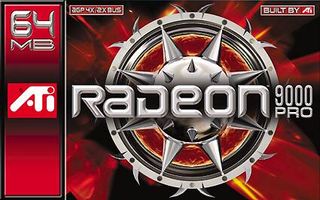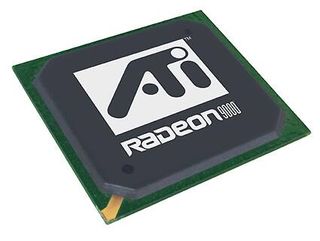The new mainstream Radeon: The 9000 series
The Technology Behind The Radeon 9000

Generally speaking the new Radeon 9000 chip is based on the Radeon 8500 design and has a vertex shading unit (v1.0) as well as a pixel shader unit (v1.4). This gives ATI a jump ahead of its San Jose-base competitor in the lower price segment ($100-$150), because it brings the first real DirectX 8 card on the market. NVIDIA'S mainstream product, GeForce4 MX, is still a pure DirectX 7 design stemming from the somewhat outdated GeForce2. Vertex shader programs can only be run with GeForce4 MX with the help of optimized software emulation in the NVIDIA driver. Even SiS, the newcomer to the 3D arena, offers pixel shader support with its new Xabre card!
| Header Cell - Column 0 | NVIDIA GF4 Ti 4200 | NVIDIA GF4 MX 460 | ATI Radeon 8500 | ATI Radeon 9000 Pro | ATI Radeon 9000 |
|---|---|---|---|---|---|
| Chip Technology | 256-bit | 256-bit | 256-bit | 256-bit | 256-bit |
| Process | 0.15 Micron | 0.15 Micron | 0.15 Micron | 0.15 Micron | 0.15 Micron |
| Transistors | 63 Mio | - | 60 Mio | - | - |
| Memory Bus | 128-bit DDR | 128-bit DDR | 128-bit DDR | 128-bit DDR | 128-bit DDR |
| Memory Bandwidth | 8,2 GB/s | 8,8 GB/s | 8,8 GB/s | 8,8 GB/s | 6,4 GB/s |
| AGP Bus | 1x/2x/4x | 1x/2x/4x | 1x/2x/4x | 1x/2x/4x/8x | 1x/2x/4x/8x |
| Memory | 64/128 MB | 128 MB | 64/128 MB | 64/128 MB | 64 MB |
| GPU Clock | 250 MHz | 300 MHz | 275 MHz | 275 MHz | 250 MHz |
| Memory Clock | (514) MHz 64 MB(444) MHz 128 MB | 275 (550) | MHz 275 (550) | MHz 275 (550) | MHz 200 (400) MHz |
| Speicher | SD/BGA 3,3-4ns | BGA 3,3ns | SD/BGA 3,3ns | SD | SD |
| Vertex Shader | 2 | - | 2 | 2 | 2 |
| Pixel Pipelines | 4 | 2 | 4 | 4 | 4 |
| Texture Units Per Pipe | 2 | 2 | 2 | 1 | 1 |
| Textures per Texture Unit | 4 | 4 | 3 | 6 | 6 |
| Vertex S. Version | 1.1 | - | 1.1 | 1.1 | 1.1 |
| Pixel S. Version | 1.3 | - | 1.4 | 1.4 | 1.4 |
| DirectX Generation | 8.0 | 7.1 | 8.1 | 8.1 | 8.1 |
| FSAA Modi | MultiSampling | MultiSampling | SuperSampling | SuperSampling | SuperSampling |
| Memory Optmizations | LMA II | LMA II | Hyper Z II | Hyper Z II | Hyper Z II |
| Display Outputs | 2 | 2 | 2 | 2 | 2 |
| Chip Internal Ramdacs | 2 x 400 MHz | 2 x 400 MHz | 2 x 400 MHz | 2 x 400 MHz | 2 x 400 MHz |
| Chip External Ramdacs | - | - | - | - | - |
| Bits per Color Channel | 8 | 8 | 8 | 8 | 8 |
| Special | - | TV Encoder On-Chip | - | TV Encoder On-Chip; FullStream | TV Encoder On-Chip; FullStream |
| Estimated Price | ~ $179 | $149 | $179 | $149 | $109 |
If you thought that the Radeon 9000 (alias RV250) would merely be a simplified version of the Radeon 8500 (R200), then you're quite mistaken. As with its predecessor, the Radeon 7500, ATI has once again integrated the functions of the Rage Theater chip and integrated a second RAMDAC in the chip. Moreover, significant modifications were made to the 3D core. Aside from performance aspects, these changes are supposed to allow for cost reductions. Fewer transistors enable a larger yield, thereby resulting in lower production costs and consequently a lower price. After all, with the OEM and mainstream markets, every penny counts.
The more significant changes have to do with the pixel pipeline. Just as with the R8500, the R9000 has four pixel pipelines. Instead of two pixels per cycle, however, these can only calculate 1 texel per cycle. In exchange, the number of textures that comprise the end pixel increases from three to six. What these confusing numbers mean in practice is that the R9000 is considerably slower than the R8500 in games with multitexturing.

The second change has to do with the vertex shader. It wasn't till now that ATI has admitted that the Radeon 8500 contains two vertex shader units, similar to the GeForce4 Ti. The reason for keeping quiet on this was more because of marketing concerns rather than understatement. The R8500 had two shader units more than NVIDIA's GeForce3. With the R9000, these units were re-worked and optimized. If the Canadian PR department is to be believed, then the new vertex shaders contain many optimizations that are also found in the R300 design.
The third and final big change affects the video capabilities. Graphics cards from ATI have the reputation of providing high quality DVD and video playback, and with good reason. As with the R300, ATI does away completely with the circuitry responsible for this and instead uses a new technology called "Videoshader". This allows ATI to combine the optimized calculations in the hardware and the flexibility of a software solution, in the form of special pixel shader programs. During video playback, the pixel shaders remain in 2D mode anyway, so they are available for this purpose. In addition, there are completely new realtime filtering capabilities available that, for example, prevent pixelation in low-resolution videos or allow special optimizations for specific video codecs such as DivX. With simple driver updates, optimizations for new video formats can be implemented. This step lets ATI save on transistors, which, in turn, has a positive effect on the price. However, it still remains to be seen how this solution works in practice.
Stay on the Cutting Edge
Join the experts who read Tom's Hardware for the inside track on enthusiast PC tech news — and have for over 25 years. We'll send breaking news and in-depth reviews of CPUs, GPUs, AI, maker hardware and more straight to your inbox.
Current page: The Technology Behind The Radeon 9000
Next Page An Overview Of The CardsMost Popular

